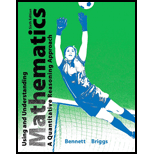
Concept explainers
The probability of rolling two dice and getting a double−1 (making a sum of 2, or “snake eyes”) is 1 in 36. Suppose you roll two dice twice. Which statement is not true?
a. The probability of getting a double -1 is 1/36 for each individual roll.
b. The probability of getting a double -1 both times is .
c. The probability of getting a double -1 on at least one of the two rolls is .
Learn your wayIncludes step-by-step video

Chapter 7 Solutions
Using and Understanding Mathematics: A Quantitative Reasoning Approach (6th Edition)
Additional Math Textbook Solutions
Calculus for Business, Economics, Life Sciences, and Social Sciences (14th Edition)
Thinking Mathematically (6th Edition)
Elementary Statistics (13th Edition)
Elementary Statistics
Calculus: Early Transcendentals (2nd Edition)
- No chatgpt pls will upvotearrow_forwardQ/By using Hart man theorem study the Stability of the critical points and draw the phase portrait of the system:- X = -4x+2xy - 8 y° = 4y² X2arrow_forwardThis means that when the Radius of Convergence of the Power Series is a "finite positive real number" r>0, then every point x of the Power Series on (-r, r) will absolutely converge (x ∈ (-r, r)). Moreover, every point x on the Power Series (-∞, -r)U(r, +∞) will diverge (|x| >r). Please explain it.arrow_forward
- Q1: A slider in a machine moves along a fixed straight rod. Its distance x cm along the rod is given below for various values of the time. Find the velocity and acceleration of the slider when t = 0.3 seconds. t(seconds) x(cm) 0 0.1 0.2 0.3 0.4 0.5 0.6 30.13 31.62 32.87 33.64 33.95 33.81 33.24 Q2: Using the Runge-Kutta method of fourth order, solve for y atr = 1.2, From dy_2xy +et = dx x²+xc* Take h=0.2. given x = 1, y = 0 Q3:Approximate the solution of the following equation using finite difference method. ly -(1-y= y = x), y(1) = 2 and y(3) = −1 On the interval (1≤x≤3).(taking h=0.5).arrow_forwardФ sketch stability x= -4x + 2xy - 8 y° = 4 y 2 - x² чуг.arrow_forward2 Q/Given H (x,y) = x² + y² - y² Find the Hamiltonian System and prove it is first integral-arrow_forward
- Q2) A: Find the region where ODEs has no limit cycle: x = y + x³ y=x+y+y³ 6arrow_forwardQ3)A: Given H(x,y)=x2-x+ y²as a first integral of an ODEs, find this ODES corresponding to H(x,y) and show the phase portrait by using Hartman theorem and by drawing graph of H(x,y)-e. Discuss the stability of critical points of the corresponding ODEs.arrow_forwardQ/ Write Example is First integral but not Conservation system.arrow_forward
 College Algebra (MindTap Course List)AlgebraISBN:9781305652231Author:R. David Gustafson, Jeff HughesPublisher:Cengage Learning
College Algebra (MindTap Course List)AlgebraISBN:9781305652231Author:R. David Gustafson, Jeff HughesPublisher:Cengage Learning Holt Mcdougal Larson Pre-algebra: Student Edition...AlgebraISBN:9780547587776Author:HOLT MCDOUGALPublisher:HOLT MCDOUGAL
Holt Mcdougal Larson Pre-algebra: Student Edition...AlgebraISBN:9780547587776Author:HOLT MCDOUGALPublisher:HOLT MCDOUGAL
 Glencoe Algebra 1, Student Edition, 9780079039897...AlgebraISBN:9780079039897Author:CarterPublisher:McGraw HillAlgebra & Trigonometry with Analytic GeometryAlgebraISBN:9781133382119Author:SwokowskiPublisher:Cengage
Glencoe Algebra 1, Student Edition, 9780079039897...AlgebraISBN:9780079039897Author:CarterPublisher:McGraw HillAlgebra & Trigonometry with Analytic GeometryAlgebraISBN:9781133382119Author:SwokowskiPublisher:Cengage




